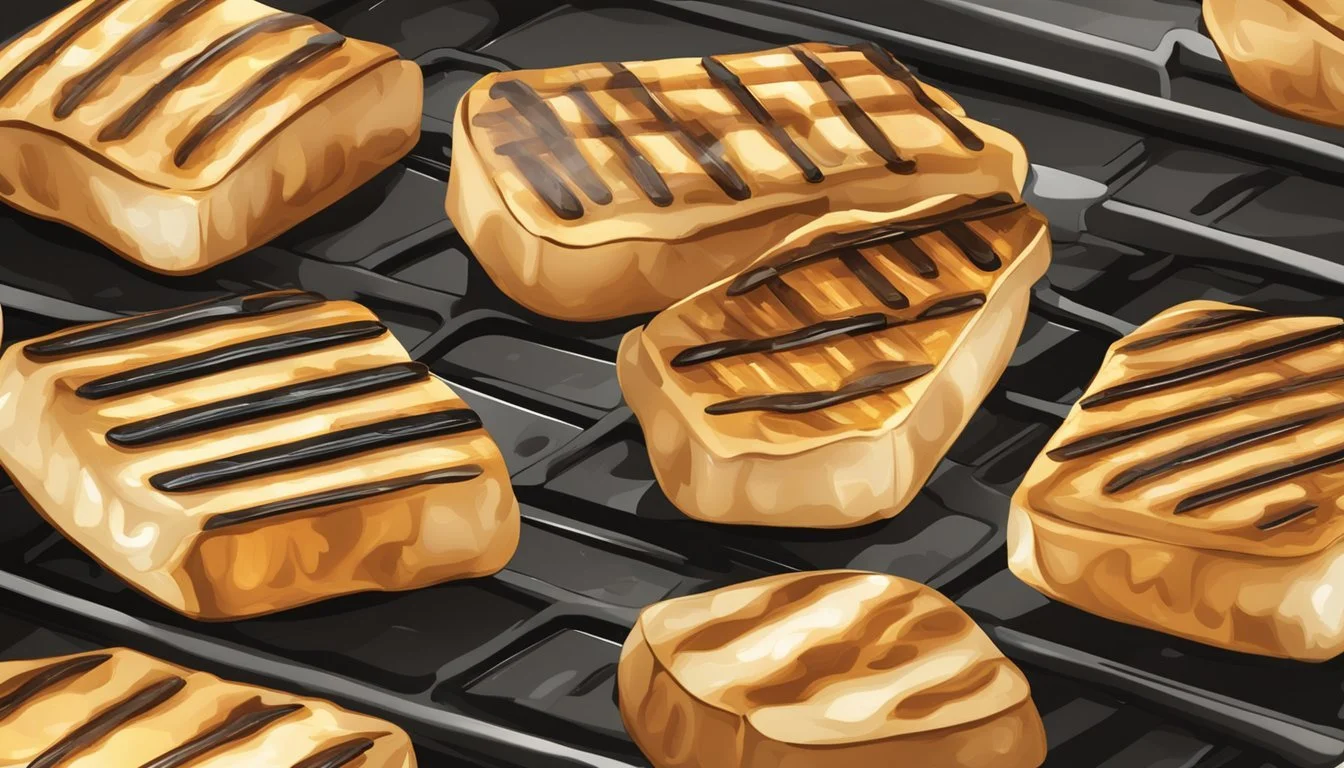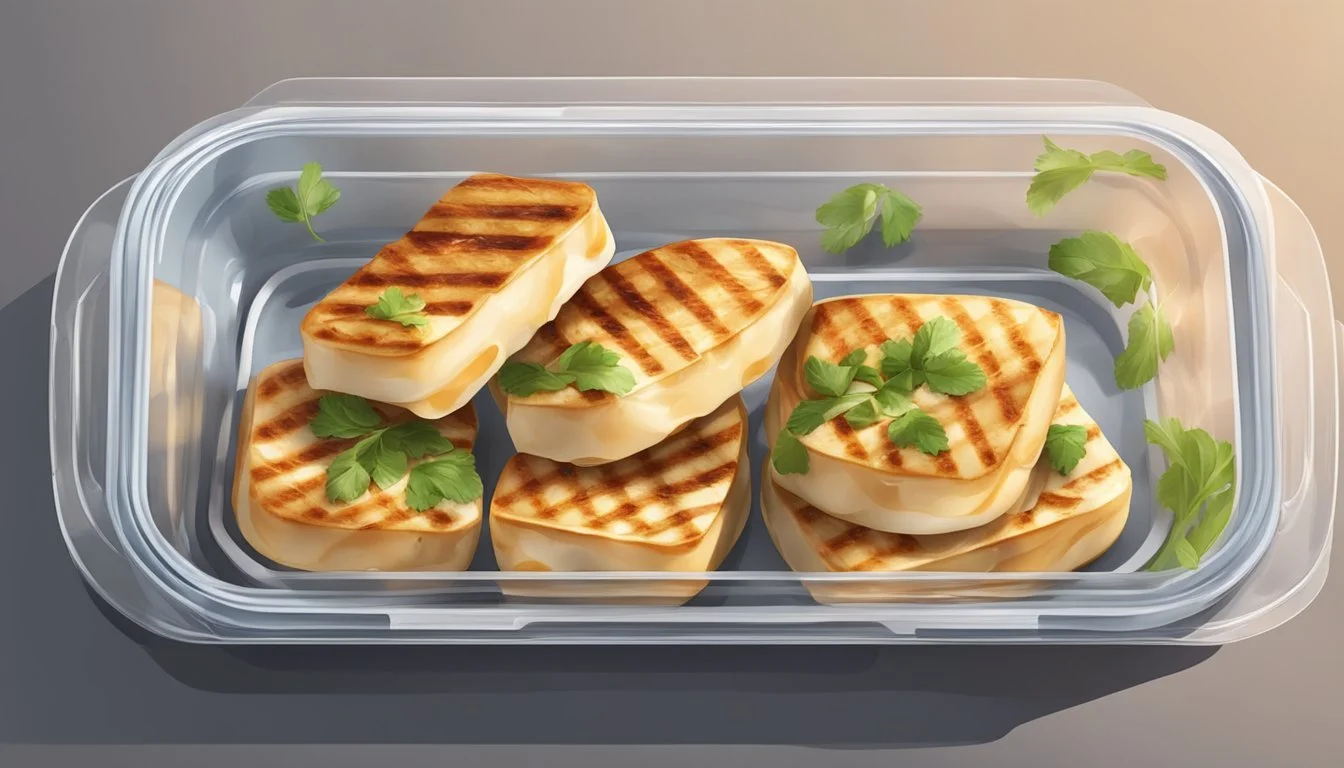How to Reheat Gluten-Free Grilled Halloumi
Tips for Perfect Texture
Reheating gluten-free grilled halloumi can preserve its delicious taste and texture if done correctly. The best method to reheat halloumi is in a preheated oven at 350°F (180°C) for about 4-5 minutes. This approach ensures the cheese stays crispy on the outside while warming evenly on the inside.
Halloumi's unique properties, such as its high melting point, make it perfect for grilling and reheating. Using an oven or toaster oven helps maintain its integrity and flavor. Additionally, for those who prefer quicker methods, using a microwave or a skillet can work, but the results may not be as satisfying.
For an enhanced experience, serve the reheated halloumi with a squeeze of lemon juice or a sprinkle of fresh herbs. This not only adds a burst of freshness but also complements the cheese's rich, savory flavor.
Understanding Halloumi Cheese
Halloumi cheese is a distinctive cheese known for its high melting point and unique texture. It originates from Cyprus and is widely recognized for its dietary benefits and robust flavor.
Origin and Popularity
Halloumi cheese hails from Cyprus, an island nation in the Eastern Mediterranean. Traditionally made from a mixture of sheep's and goat's milk, it reflects the rich culinary heritage of the region.
Cyprus has a long history of halloumi production, with the cheese gaining international popularity for its versatility. Today, halloumi is enjoyed worldwide, especially in grilled or fried forms.
Nutrition and Dietary Benefits
Halloumi provides a good source of protein and calcium. A typical serving (about 30 grams) contains approximately 7 grams of protein and 20% of the recommended daily intake of calcium.
Nutritional Highlights:
High in Protein: Supports muscle repair and growth.
Rich in Calcium: Essential for bone health.
Moderate in Fat: Contains both saturated and unsaturated fats.
For those seeking gluten-free options, halloumi is naturally gluten-free, making it a suitable choice for individuals with gluten sensitivities or celiac disease.
Characteristics: Texture, Taste, and Melting Point
Halloumi is known for its firm texture and ability to retain its shape when cooked. This characteristic makes it ideal for grilling or frying, as it does not melt completely but rather achieves a delightful crispy exterior with a chewy interior.
Texture: Firm and slightly rubbery when raw, but it becomes crispy on the outside and soft on the inside when cooked.
Taste: Salty and tangy, often described as fresh and slightly briny. The flavor intensifies when grilled or fried.
High Melting Point: Unique among cheeses, its high melting point prevents it from melting into a gooey mess, allowing it to be used in various culinary preparations that require direct heat like grilling or frying.
Preparation of Grilled Halloumi
Grilling halloumi requires the right ingredients and techniques to achieve that perfect, squeaky texture. Pay attention to the specific nuances in grilling techniques and tips to maintain ideal grill marks and a delightful texture.
Ingredients Required for Grilling
Halloumi Cheese: Choose fresh, high-quality halloumi. It should feel firm and have a distinct, squeaky texture.
Olive Oil: Extra virgin olive oil helps prevent sticking and adds a rich flavor.
Seasonings: Italian seasoning, fresh herbs, lemon wedges, black pepper, and chili flakes can enhance the flavor profile.
Optional Ingredients: Consider brushing the halloumi with honey or serving it with lemon juice for a tangy twist.
Grilling Techniques and Tips
Preheat the Grill_: Ensure the grill (or grill pan) is hot, around 425°F, to prevent sticking.
Oil the Grill: Lightly brush the grill grates with olive oil to create a non-stick surface.
Cut Halloumi: Slice halloumi into even slabs for uniform cooking.
Season: Brush halloumi slices with a mix of olive oil and seasoning on all sides.
Grill: Place halloumi on the grill, cooking for 2-3 minutes per side until grill marks form.
Avoid Overcrowding: Give each slice enough space to cook evenly and avoid steaming.
Maintaining the Perfect Grill Marks and Texture
Correct Heat: Maintain medium-high, direct heat to ensure even cooking without burning.
Frequent Turning: Turn halloumi only once during grilling to achieve distinct, even grill marks.
Monitor Cooking Time: Cook until a golden-brown crust forms, usually about 2-3 minutes per side.
Storage and Reheating: Serve halloumi immediately for the best texture. If reheating, use a toaster oven for 2-3 minutes at 350°F to retain its squeakiness.
Immediate Serving: Grilled halloumi tastes best when served hot; add fresh herbs and a squeeze of lemon juice to enhance the flavor right before serving.
By following these steps and tips, one can achieve perfectly grilled halloumi with the ideal texture and flavor.
Reheating Gluten-Free Grilled Halloumi
Properly reheating halloumi ensures it retains its taste and avoids becoming rubbery. Heat and timing are crucial factors to consider for the best flavor and texture.
Best Methods for Reheating to Retain Quality
Oven: Preheat to 350°F (180°C). Place the grilled halloumi on a wire rack or ridged foil over a baking tray. The wire rack allows for even heating, preserving quality. Reheat for 4-5 minutes.
Toaster Oven: Similar to a conventional oven but quicker. Preheat to 350°F (180°C) and place the halloumi slices inside for approximately 2-3 minutes.
Air Fryer: Set the temperature to 350°F (180°C) and reheat for 2-3 minutes. This method provides a quick and even reheating process.
Adjusting Heat to Avoid A Rubbery Texture
Maintaining the right temperature is crucial for avoiding a rubbery texture. Low and Slow: Aim for a moderate temperature of 350°F (180°C). High heat can cause the cheese to toughen.
Consistent Temperature: Use an oven thermometer to ensure a steady heat. Fluctuating temperatures can result in uneven reheating and alter the texture.
Avoid Overheating: Stick to the recommended time frames. Overheating leads to loss of moisture and a chewy texture.
Timing and Techniques for Optimal Results
Timing Depends on Slice Thickness: Thicker slices need a little more time to warm thoroughly. Thin slices can be ready in a minute or two less.
Monitor Closely: Keep an eye on the halloumi. Once it starts to sizzle and shows slight browning, it's ready.
Serve Immediately: Best enjoyed hot off the heat. Delays in serving can affect texture, making it less appealing.
Serving and Pairing Suggestions
Grilled halloumi is versatile, blending seamlessly into many dishes, from fresh salads to hearty sandwiches and nutritious breakfasts.
Salads and Appetizers
Grilled halloumi pairs wonderfully with salads. It adds a savory, chewy texture to mixed greens or grain bowls.
Mediterranean Salad: Mix grilled halloumi with tomatoes, cucumbers, red onions, and olives. Drizzle with olive oil and lemon juice.
Fruit and Nut Salad: Combine grilled halloumi with mixed greens, figs, or strawberries. Top with nuts and a honey-lemon vinaigrette.
For appetizers, serve grilled halloumi with dips like hummus or tzatziki. Add pita bread slices for a complete Mediterranean experience.
Sandwiches and Burgers
Grilled halloumi is an excellent addition to sandwiches and burgers.
Veggie Halloumi Sandwich: Layer grilled halloumi with roasted red peppers, fresh spinach, and a drizzle of balsamic glaze between two slices of gluten-free bread.
Halloumi Burger: Place a thick slice of grilled halloumi on a gluten-free burger bun. Add avocado, lettuce, tomato, and a spread of tzatziki or aioli for extra flavor.
These options provide a satisfying, meat-free alternative with rich textures and flavors.
Incorporating Grilled Halloumi into Breakfast
Grilled halloumi can elevate breakfast dishes, offering a unique twist to morning meals.
Egg and Halloumi Breakfast Bowl: Combine grilled halloumi with scrambled eggs, avocado, and sautéed spinach. Top with a sprinkle of red pepper flakes.
Halloumi and Veggie Breakfast Pita: Fill a gluten-free pita with grilled halloumi, cherry tomatoes, cucumbers, and a dollop of hummus.
These breakfast ideas are flavorful and packed with protein, making them a great way to start the day.
Alternative Uses of Halloumi in Cooking
Halloumi is an adaptable cheese often used in grilling but it also shines in various culinary contexts. It pairs exceptionally with vegetables, making it a versatile ingredient for different diet preferences.
Innovative Recipes including Grilled Halloumi
Grilled halloumi adds a unique twist to many recipes. One popular dish is halloumi tacos, where the cheese substitutes meat, offering a rich, chewy texture. Combined with zesty corn salad and a creamy cilantro sauce, it's a hit at summer BBQs.
Another innovative idea is halloumi cheese sticks. Simply slice the halloumi into sticks, fry until crispy, and serve as a delicious appetizer or snack. Additionally, integrating grilled halloumi in a Caprese salad with cherry tomatoes and basil brings a new depth of flavor.
Vegetarian and Low-Carb Options
For those following a vegetarian or low-carb diet, halloumi is a pivotal ingredient. It can be used in a veggie burger, providing a hearty, satisfying bite when fried or grilled. Pair it with eggplant and a selection of fresh vegetables for a complete meal.
Halloumi also fits perfectly into a keto-friendly diet due to its high protein and low carbohydrate content. In keto recipes, it can replace traditional proteins like chicken or beef in dishes like halloumi gyros. Simply grill the halloumi and serve in lettuce wraps with tzatziki sauce.
Using Leftover Grilled Halloumi
Leftover grilled halloumi should never go to waste. Transform it into a halloumi cheese sandwich for a quick lunch. Simply layer it with fresh veggies and a drizzle of olive oil.
Incorporate leftover halloumi into skewers with cherry tomatoes and bell peppers for an easy appetizer. Reheating halloumi in a griddle or oven retains its texture and flavor, making it an excellent addition to salads or grain bowls.
With such flexibility, grilled halloumi becomes an essential component in numerous recipes, catering to various tastes and dietary needs.
Proper Storage and Handling
Proper storage and handling are crucial to maintaining the texture and flavor of gluten-free grilled halloumi. Following best practices can help preserve its unique qualities and prolong its shelf life.
Storing Halloumi Before and After Grilling
Unopened halloumi should be stored in the refrigerator, preferably in its original packaging, which helps keep it moist and fresh. Once opened, any leftover halloumi should be tightly wrapped in a paper towel and then placed in an airtight container. This minimizes exposure to air and moisture, which can degrade the cheese's texture and flavor.
After grilling, halloumi should be placed on a clean serving platter and covered with aluminum foil to retain its warmth and prevent it from drying out. If you have extra grilled halloumi, let it cool to room temperature before storing it in the fridge. Again, wrapping it in a paper towel and keeping it in an airtight container is essential to maintain its freshness.
Maximizing Freshness and Longevity
To maximize the freshness and longevity of your halloumi, consider immersing it in a mixture of extra-virgin olive oil and fresh herbs like thyme. This method not only extends its shelf life but also imparts additional flavors. Additionally, if you have grilled halloumi, storing it with a few sprigs of fresh thyme can enhance its taste.
When reheating, it's important to use appropriate methods to avoid making the cheese rubbery. Preheating the oven to 350°F and placing the halloumi on a wire rack or a baking tray lined with ridged foil can help achieve even heating. This ensures your reheated halloumi retains its appealing texture and flavor.
Taking these steps ensures that gluten-free grilled halloumi is as delicious when reheated as it is fresh off the grill.






